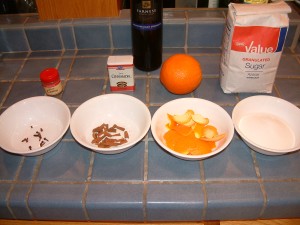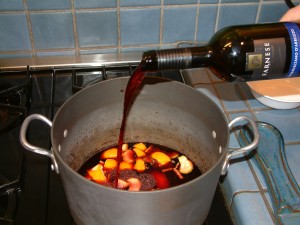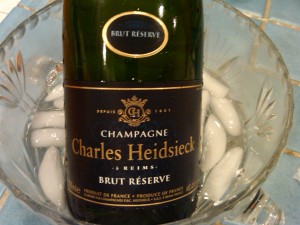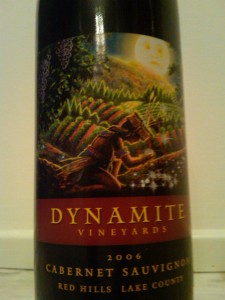With the vast number of wine producing regions throughout the world, each with its own mix of climate and soil, it easy to understand how a very versatile grape like chardonnay has spread to so many of them. Chardonnay has the great ability to show off its wine-maker’s talents as well as the climate and soil in which it grew. Depending on the climate in which it grows, chardonnay has flavors that can range from green fruit (e.g. green apples and pears) to citrus and stone fruits (e.g. lemons and oranges, peaches and apricots) to tropical fruits (e.g. pineapples and melons) and more. A wine-maker can also make decisions which will influence and even alter the wine’s flavor and texture profiles. In order to showcase this effect, I decided to match up the two chardonnays from the Morgan Winery under the 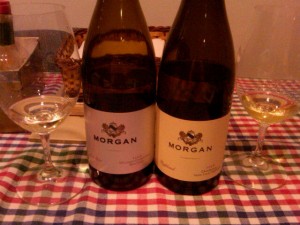 careful craftsmanship of Gianni Abate. The chardonnays are the 2009 Morgan Metallico from Monterey and the 2008 Morgan Highland from the Santa Lucia Highlands (a specific area within Monterey County). Mind you, these are both the current releases and while they come from different vintages, the stylistic differences are the focus of this article.
careful craftsmanship of Gianni Abate. The chardonnays are the 2009 Morgan Metallico from Monterey and the 2008 Morgan Highland from the Santa Lucia Highlands (a specific area within Monterey County). Mind you, these are both the current releases and while they come from different vintages, the stylistic differences are the focus of this article.
First off, let’s compare the wine making process involved to understand how the differences evolve. The most important factor in how these wines vary is found in their fermentation and aging process. The Metallico, which is made from grapes from the Santa Lucia Highlands and Arroyo Seco appellations of Monterey, was fermented and aged absent of oak and not allowed to undergo any malo-lactic fermentation. The Highland, on the other hand, was fermented in oak barrels and underwent a partial malo-lactic conversion. Malo-lactic fermentation is a secondary fermentation in the wine where the malic acid, which gives it apple and green pear flavors (“malum” being the Latin word for “apple”), converts to lactic acid, giving the wine a creamy, buttery texture (think “lactose” or dairy). Wine-makers can control this secondary event by adding a secondary fermenting agent and controlling the temperature at which the fermenting wine is kept. But enough about the technical jargon, let’s see how the wines match up.
Before opening up the two bottles we can tell that the un-oaked chardonnay will be lighter: oak not only changes the flavor profile but also makes the body of the wine fuller and heavier. That said, the Metallico is lighter than the Highland in two ways. Not only is the “body” of the wine lighter, but so is the color. Side by side we can see that the Metallico is a light almost straw-colored wine while the Highland has a deeper, more golden color. The color is affected in two ways: the first has to do with the amount (length of time) of skin contact the grape juice gets at the beginning of its transformation into wine (called “extraction”); the second comes from oak contact.
Well, since looking at a wine is fun for about ten seconds, let’s start seeing just what these two wines have to offer. My suggestion, and what I did, is to open both bottles and pour a bit of each into a couple of glasses, ideally two of the same kind of glasses. Nose them one at a time, starting with the Metallico. The un-oaked chardonnay had a moderately pronounced bouquet that opened with a combination of green apples and apricots over an underlying hint of minerality. As the wine breathed it began to develop more citrus notes to it as well. The range of flavors helps show that the grapes came from a couple of vineyards, each exposed to different climates, both cooler and warmer. Now smell the Highland. You’ll notice that it has a very pronounced nose that is full of vanilla and oak notes with hints of coconut and sweet apple. The oak truly prevails in the nose of this wine, especially while the wine is still tight and has not had much time to breathe.
Hopefully by now, your mouth is starting to water and you’re ready to start tasting. Go ahead, starting again with the Metallico before the Highland, but make sure to give proper attention and time to each one. The Metallico is surprisingly weighty for an un-oaked wine. It has a full and round mouth-feel whose acidity starts off tucked away but comes racing out once the wine opens with air. On the tongue the flavors taste of ripe peach and apricot with a hint of spice. It also has good citrus notes but, like the acidity, they are slow out of the gate but long lasting. The wine has a fairly long finish. All in all it is a great chardonnay that reminds me a bit of some of the chardonnays of the Macon region of southern Burgundy.
Now try the Highland and you’ll find a very different wine. It too is full-bodied, but not as big as many other oaked chardonnays out there. The Highland has noticeable acidity in the palate, a sign that it didn’t undergo a full malo-lactic conversion as the secondary fermentation softens the acidity, enough that it leaves a smooth and creamy mouth-feel in its place. Also, I noticed a slight heat from the alcohol at the back of my mouth, not really a burn per se, but a detectable presence. The difference in alcohol by volume (abv) between the two different wines is less than a percent, the Highland clocking in at 14.2% while the Metallico is only 13.5%. The fact that I noticed the difference in the mouth isn’t just because the Highland is higher; it also speaks to the balance of the different factors in the mouth: acidity, sugar, alcohol and body. On the palate the oak was very prevalent, giving the wine flavors of coconut and vanilla, as well as butter from the malo-lactic fermentation. The wine also had a nice touch of golden delicious apple to it and a very slight tropical fruit hint. The Highland has a long finish, longer than its counterpart. This is a very Californian style chardonnay where the oak takes the driver’s seat and runs the long course over your tongue, only leaving room for the fruit flavors of the grape in the back seat. Unlike many of the California oaked chardonnays though, this wine still had great balance, acidity and fruit to it (“back seat” though it might be). Many wineries in California produce chardonnays that are so heavily oaked, all you can get are the flavors of the barrel and the butter from secondary fermentation.
As you can see from these descriptions, these two wines, both from the same grape, (relatively) same region and the same wine-maker are vastly different. This is the great control a wine-maker has: a versatile grape like chardonnay can be guided or molded into a final product that reflects the tastes and goals of its creator. The oenologist can craft the wine to display the soil and weather in which it grew, radically change the flavors of the juice with a secondary fermentation and long exposure to oak barrels, or she can produce a wine anywhere in between.
So next time you decide to grab a bottle of chardonnay, think about how it tastes and why that might be. Do you like the citrus flavors and sharp, crisp acidity of a good Chablis or the vanilla and cream of a fat, rich butter-bomb from Napa? How does it go with what you’re eating? Think about what factors and flavors appeal to you. Once you start figuring that out, start trying different chardonnays and look for suggestions from sommeliers and wine store employees that would be in the same vein.
Salute!



